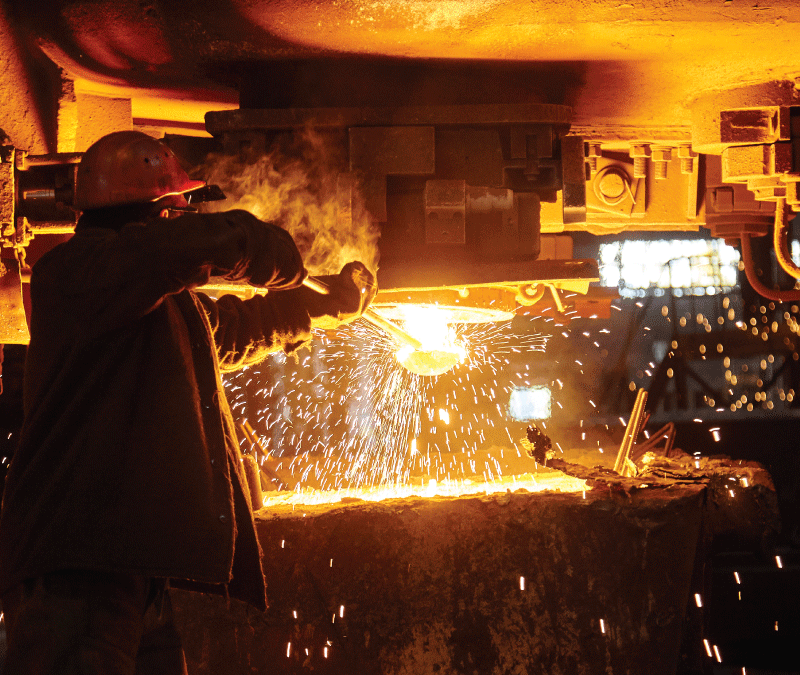Yes—most hydraulic fluids are flammable. However, the degree of flammability varies significantly depending on the base type of the fluid. In industrial settings where equipment operates under high pressure and heat, a fire fueled by hydraulic fluid can pose serious risks to personnel and property.
Choosing the right hydraulic fluid is critical for operational safety. Understanding what makes hydraulic fluids flammable and which options offer fire resistance can help you select a solution tailored to your work environment.
Flammability of Different Types of Hydraulic Fluid
The base composition of a fluid—whether it’s mineral oil, synthetic, water-based, or biodegradable—plays a major role in how it reacts under heat and pressure. Understanding the differences between these types is essential for choosing the right hydraulic fluid for your application and minimizing fire risk.
Mineral Oil-Based Hydraulic Fluid
This is the most common type of hydraulic fluid and also among the most flammable. Derived from petroleum, it has a relatively low flashpoint and ignites easily when sprayed or leaked onto a hot surface.
Synthetic Hydraulic Fluid
Synthetic fluids offer improved performance in extreme temperatures, but not all are fire-resistant. Some synthetic blends are engineered to be less flammable, while others retain a risk of ignition. Always review the technical data sheet for flashpoint and firepoint.
Water-Based Hydraulic Fluid
These fluids include water-glycol and water-oil emulsions. Thanks to high water content, they have very low flammability and are often used in fire-sensitive environments like steel mills or underground mining.
Biodegradable Hydraulic Fluid
Eco-friendly or environmentally responsible fluids, like those based on vegetable oil or synthetic esters, can vary in flammability. While many biodegradable fluids perform well in terms of lubrication, not all meet fire resistance standards. Look for Factory Mutual (FM) -certified HFDU options like BioBlend’s BioFlo HFDU and BioFlo Synthetic HFDU fluids when fire safety is a concern.
Comparison of Hydraulic Fluid Flammability
| Hydraulic Fluid Type | Flashpoint | Firepoint | Common Applications |
| Mineral Oil-Based | ~150°C / 302°F | ~200°C / 392°F | Manufacturing, construction, and agriculture |
| Synthetic | ~180°C / 356°F | ~220°C / 428°F | Mobile equipment, aerospace |
| Water-Based | ~149°C / 300°F | ~232°C / 450°F | Steel plants, mining |
| Biodegradable | ~250°C / 482°F | ~300°C / 572°F | High-temperature, fire-prone sites |
Note that these figures are general estimates for non-HFDU products. Actual performance will vary by provider. Always consult your owners manual(s) for proper hydraulic fluid requirements. Depending upon your operation your insurance company may have additional fire resistance requirements or suggestions.
Who Needs Non-Flammable Hydraulic Fluid?
Industries where hydraulic systems operate near open flames, molten metal, or hot surfaces benefit most from non-flammable or fire-resistant hydraulic fluids. These include:
- Steel manufacturing
- Foundries
- Mining operations
- Aviation and aerospace
- Offshore drilling platforms
- Forestry and logging
- Defense and military vehicles
Ways to Minimize Risks of Using Flammable Hydraulic Fluid
If using a flammable fluid is unavoidable, implement these precautions to reduce fire hazards:
- Regularly inspect hoses and seals for leaks
- Use hydraulic components rated for high temperatures
- Keep flammable fluids away from ignition sources
- Install fire suppression systems near hydraulic equipment
- Follow proper fluid storage and disposal protocols
- Train employees on emergency fire response
Key Features of Fire-Resistant Hydraulic Fluids
When safety is a top priority, fire-resistant hydraulic fluids provide a critical layer of protection in high-risk environments. These specialized fluids are engineered to minimize the chances of ignition and reduce the spread of fire if an incident occurs.
Below are the benefits that set HFDU hydraulic fluids apart from conventional options:
- High flashpoint (>572°F/300°C)
- High firepoint (>680°F/360°C)
- Self-extinguishing properties
- Thermally stable under pressure
- Biodegradable and non-toxic options are available
- OEM approvals for fire-prone environments
- Low smoke emission on ignition
Why Fire-Resistant Hydraulic Fluid Is the Best Choice
While it’s possible to reduce the risk of hydraulic fires through maintenance and design, switching to a fire-resistant hydraulic fluid is the single most effective solution.
Products like BioFlo Synthetic HFDU and BioFlo HFDU are both Factory Mutual (FM) approved, offer exceptional fire resistance, high-performance lubrication, and environmental safety. These fluids are engineered to protect your people and equipment in high-heat and high-risk environments, without sacrificing operational efficiency.
Frequently Asked Questions
Is hydraulic fluid flammable?
Yes, most types are. However, fire-resistant options such as HFDU fluids significantly reduce ignition risk.
What does flashpoint mean in hydraulic fluids?
Flashpoint is the lowest temperature at which a fluid can vaporize to form an ignitable mixture in air.
What’s the difference between flashpoint and firepoint?
The flash point of a lubricant is the lowest temperature at which its vapors briefly ignite when exposed to a flame or spark. In contrast, the fire point is the lowest temperature at which those vapors continue to burn for at least five seconds after ignition. Simply put, the flash point marks when the vapor lights and quickly goes out, while the fire point indicates the temperature at which the vapor sustains a flame. The fire point is generally 5 to 10°C higher than the flash point..
Are biodegradable fluids fire-resistant?
Not always. Some are engineered for fire resistance, but others may not meet safety standards. For instance, BioBlend products are available in both types.
Can I retrofit existing equipment to use fire-resistant fluid?
Yes — most modern fire-resistant hydraulic fluids are compatible with standard hydraulic systems. Always verify with your equipment manufacturer.

